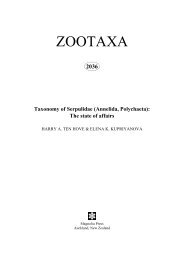You also want an ePaper? Increase the reach of your titles
YUMPU automatically turns print PDFs into web optimized ePapers that Google loves.
Two specimens (dos Santos 75, Rabelo 87) have pinnae bases with small spines but these appear different<br />
from the pinnae bases of D. mitis (pinnae bases with uneven surfaces at the bases adaxially, usually covered<br />
with spinules and/or dense tomentum). Some specimens (Calderon 2709, Carvalho 2149, Cid 10996, dos<br />
Santos 757) have distal pinnae intermediate between acanthophylls and more usual pinnae, almost like those<br />
of D. chinantlensis and similar species.<br />
22. Desmoncus setosus Martius (1823–1837: 89).<br />
Atitara setosa (Martius) Kuntze (1891: 727). Lectotype (here designated):—BRAZIL. Amazonas: Rio Japurá, near Tefé,<br />
no date, C. Martius s. n. (M!). Epitype (here designated):—BRAZIL. Amazonas: Mun. Tefé, near mouth of Rio<br />
Tefé, 19 January 1991, A. Henderson & J. Guedes 1588 (epitype INPA!, isoepitype NY!).<br />
Plants 7.0(2.0–15.0) m tall; stems 0.7(0.5–1.1) cm diameter. Leaf petioles 2.0(1.0–4.0) cm long; rachises<br />
41.7(14.0–67.0) cm long, 2.9(2.2–4.1) mm wide, the spines usually
















